In this post I’ll show you how to:
- How to hold your pick
- How to strum with your fingers
- Beginner and advanced strumming patterns
- Beginner and advanced strumming techniques
After this article, you’ll be impressing your friends and family in no time with your playing.
Let’s get started!
Should you play guitar with a pick or do finger strumming?
This can be a tricky decision for beginner guitar players. But, honestly, there isn’t a right or wrong decision. It all depends on your goals and what will inspire you to pick up your guitar and play.
However, for most beginners, it will be easiest to learn with a guitar pick. This is because guitar picks offer more control, consistency, structure, and predictability.
Playing with your fingers requires more fine motor control and technique.
For this reason, I would recommend if you are a beginning guitar player to learn with a pick.
However, you will want to become proficient at both. I play with a pick in my own guitar playing when I’m playing the electric guitar, and use my fingers when playing acoustic.
Also, since picks have a brighter sound, it’s usually a good idea to use one when playing with other musicians. Your guitar will have a better chance of cutting through the music.
Fingerstyle playing can be more warm and round sounding and less bright. Better for singer/songwriters who want a more intimate sound from their instrument.
How to strum a guitar properly
Regardless if you are playing with a pick or your fingers, you need to know how to hold and strum your guitar properly.
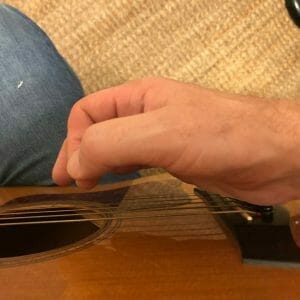
Your wrist
Great strumming technique comes from a relaxed and controlled wrist.
To accomplish this, I like to ever-so-slightly rest the palm of my strumming hand on the bottom half of the bridge saddle. But, of course, you want to keep your hand at an angle to not accidentally mute any of the strings.
I find that this gives you extra control and sets you up for more advanced techniques like palm muting, which we will discuss later in this article.
Your forearm and elbow
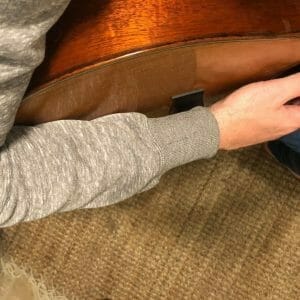
The forearm of your strumming arm should be straight when you strum. If you correctly use your wrist, your forearm shouldn’t move up and down but have a slight twisting motion.
Use your elbow and armpit to gently squeeze your guitar’s body against your ribs to hold your guitar in place.
Posture
It’s best practice to play with a straight back and your feet flat against the floor.
However, I’d be a hypocrite to be strict about this. I learned how to play guitar sprawled on a couch watching tv during the winter in the midwest.
Be aware of your body and not hurt it. But also remember to do what’s comfortable and keeps you playing.
For those playing a lot of guitar, it is recommended to buy a dedicated guitar chair or stool for comfortability and posture.
How to strum with a pick
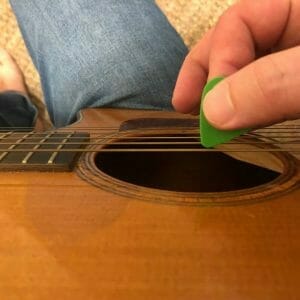
Simply grip the pick with your thumb and first finger.
Hold the pick with a little more pressure with the inside thumb, so your pick has a bit of wiggle to it.
Playing with a pick at first will be awkward, and you will drop it often.
If you are playing an acoustic guitar, then get good at fishing out your pick from the soundhole (don’t worry, it happens to the best of us!)
The more you practice holding your pick, the more comfortable it will get.
However, resist holding your pick with a death grip. Instead, keep a loose fist and relaxed elbow.
Try holding the pick at a 45-degree angle and only apply light pressure when you strum. This will help you avoid the pick from “biting” the strings and falling out of your hand.
How to strum with your thumb
You can use a thumb-pick when your strumming with your thumb. However, in my opinion, this misses out on the magic you get when you play all-natural.
The tone you get from playing with your thumb is a warm and round one. It’s one of my favorite ways to strum a guitar; however, it comes with challenges.
You want the fleshy part of your thumb to hit the strings. This is relatively easy on the downstroke, but it’s easy to catch your fingernails on the upstroke. This will significantly alter the tone of your strumming and can sound uneven and weird.
I’ve found that if you angle your thumb almost parallel to the strings, you can easily prevent this from happening.
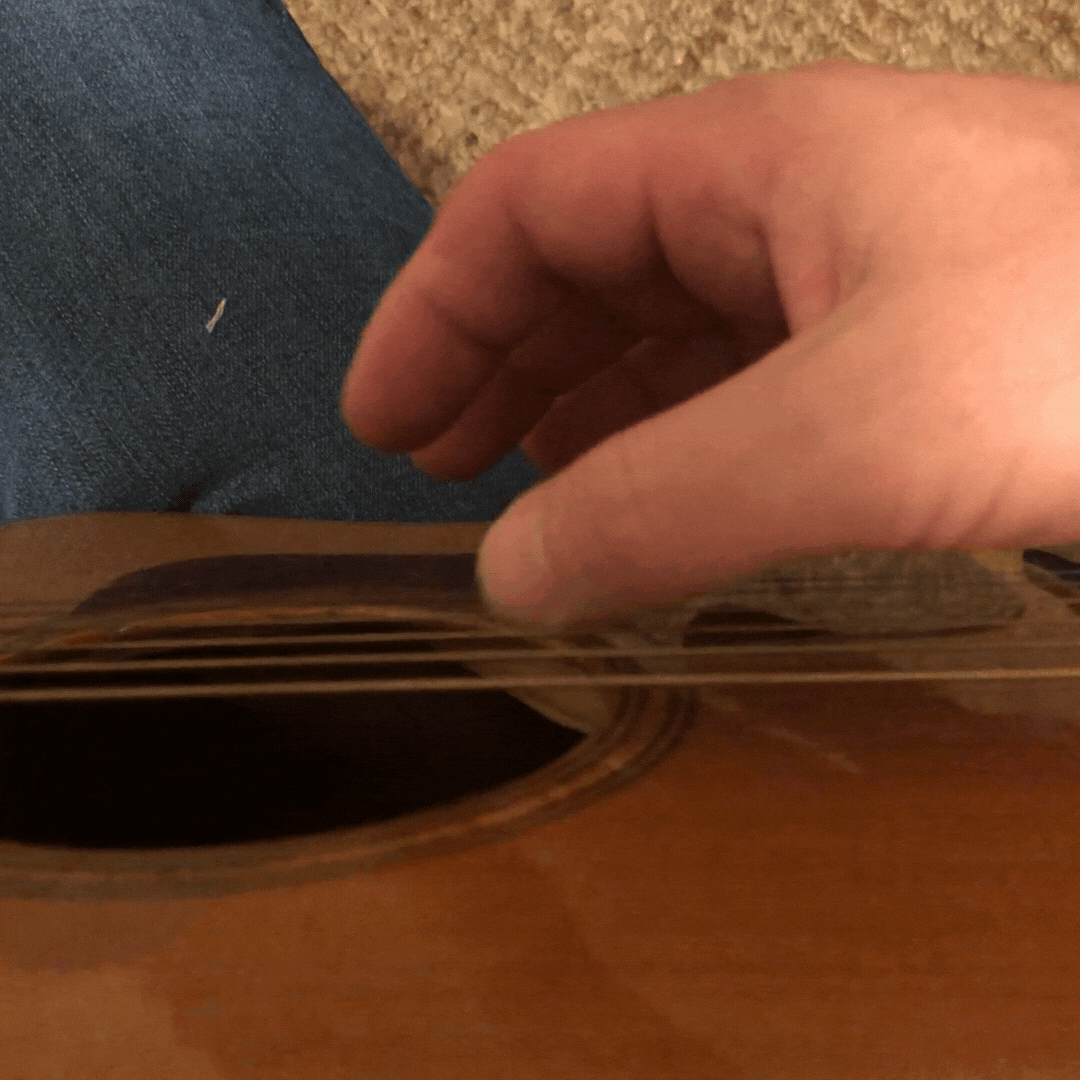
How to strum with your index finger
Strumming with your index finger is an excellent alternative to strumming with your thumb when you want a more aggressive sound.
You can think of your index finger as a “natural pick” because your fingernail gives you the same type of vibe.
You will naturally hit the strings with your fingernail on the downstroke and the fleshy part of your finger on the upstroke. This is the opposite of the thumb, and this combination is less awkward-sounding. So you can be looser and alternate between nail and flesh without it sounding bad. Just be careful with cutting your finger’s cuticle on the strings.
The challenge with strumming on your index finger is that it takes quite a bit of control and practice to stay on rhythm.
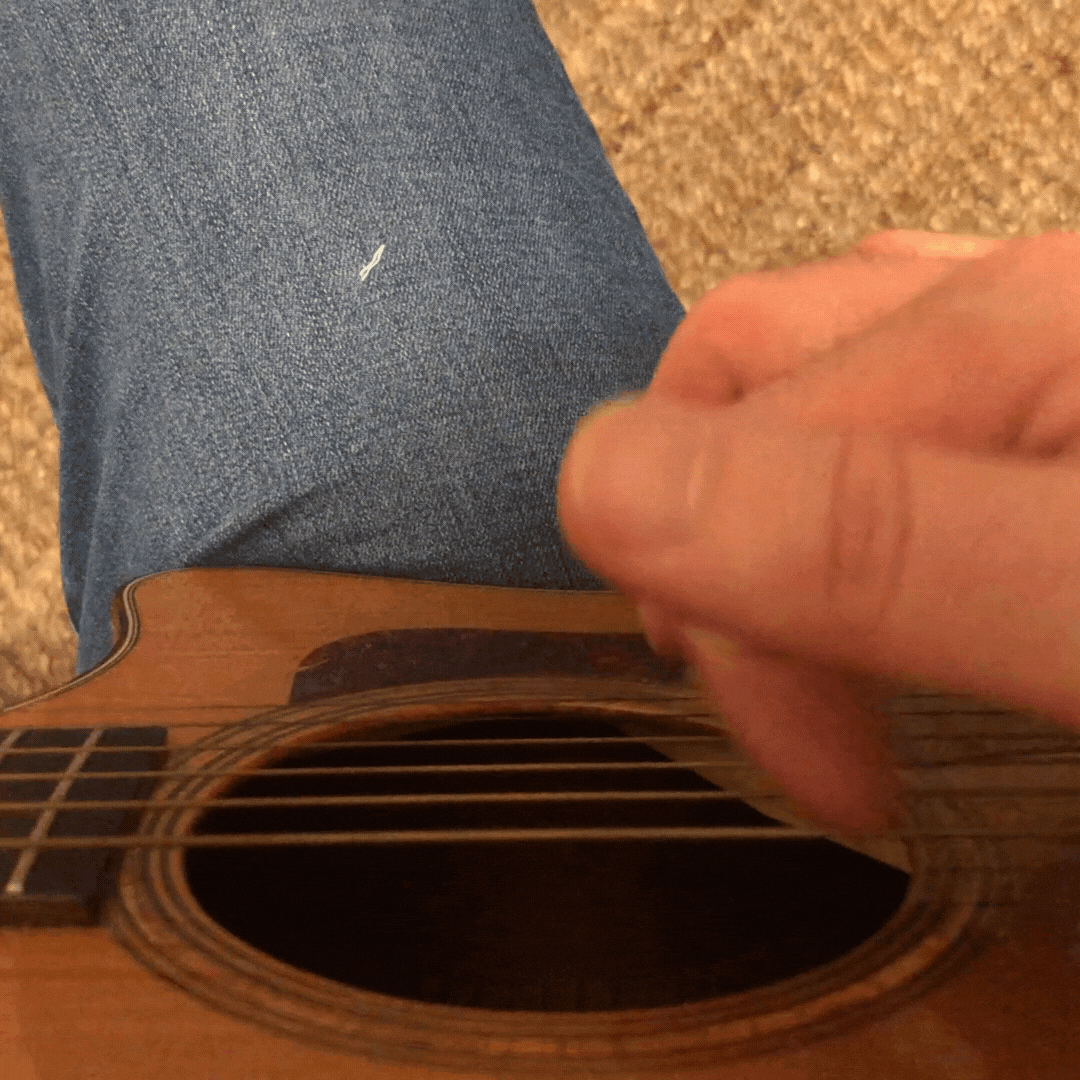
How to combine your thumb and index finger
This strumming combination is my jam!
This advanced strumming technique uses your thumb as the dominant rhythm keeper and the index as the accent notes.
You’re combing the warm and round tone of your thumb with the bright attack of your index finger’s nail.
This can create excellent dynamics in your guitar playing and really make your sound stand out.
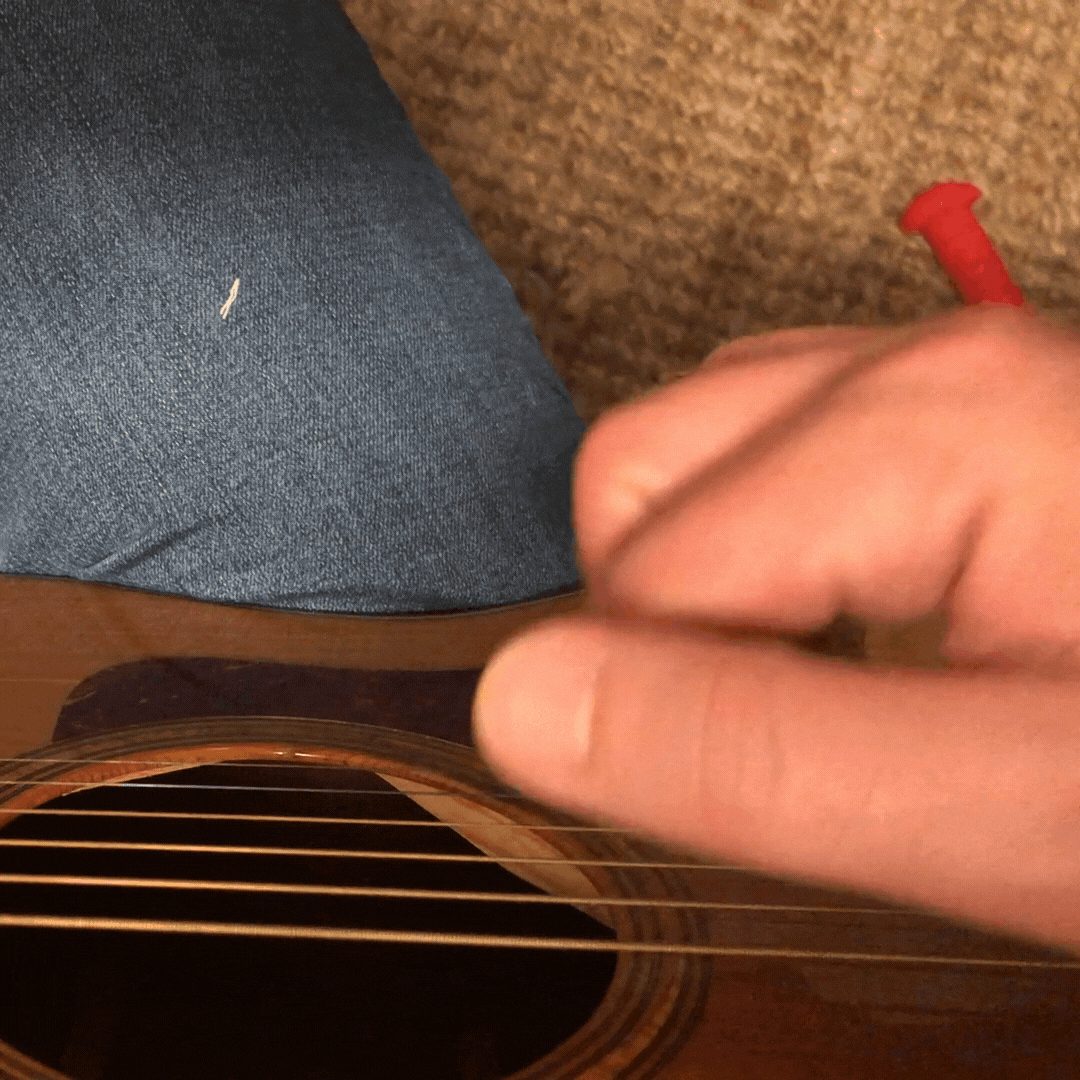
Adding other fingers
You can add the rest of your fingers to your strumming pattern to create even more variety and dynamics.
This is basically Travis Picking, and it’s a very advanced strumming and fingerpicking technique.
It will require a lot of hand control and practice to get proficient at. However, it’s a worthy pursuit as it opens up an entirely new world of guitar playing beyond basic strumming.
For beginners, it might take years to get to this point in your playing, so don’t worry too much about it if you’re just starting your guitar journey.
Different Strokes, Different Folks
Practice makes perfect. And this is especially true when it comes to learning how to strum a guitar that keeps you excited to play.
Fortunately, strumming isn’t all that complicated and can be broken into two motions:
- Downstroke
- Upstroke
The downstroke moves from Low E to High E.
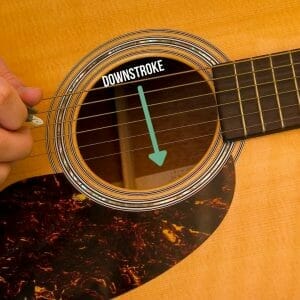
Up strokes are the accent notes in-between your downstrokes.
Generally, with upstrokes, you will not strum all six strings (or 8 strings if you’re into the djent kind of thing). So to keep your strumming patterns smooth, you should only lightly upstroke the High E, B, and G strings.

One pro tip when strumming is to never stop moving your strumming hand. Your arm should look like you’re playing a shaker.
Helpful tips for your progression
You’re going to develop bad habits as you learn guitar; we all do. However, there are a few tips to make your progression as a guitarist go more smoothly and avoid developing really bad habits.
- Don’t strum the guitar straight up and down (this will make it sound clunky)
- When you’re first starting to learn how to strum, mute the strings with your fretting hand. Don’t try and play chords, as this will add an extra layer of complexity to learning guitar. It may not be very inspiring, but it will help you to grow.
- Play with a metronome. Most guitarists learn by feel. However, you’ll play better with other musicians and record a lot better when your rhythm is rock solid.
Rhythm is a huge topic on its own. If you want to take a deeper dive into rhythm on how to utilize it for your songwriting and guitar playing, please refer to my article “Everything You Need To Know About Rhythm in Music As a Songwriter.”
The THREE strumming patterns that matter
Don’t overcomplicate your strumming. There are three main patterns that you should learn. These are ordered from easiest to most difficult.
Down Down Down Down
Simply strum the guitar on the quarter notes of the measure. For example, if you count out loud 1, 2, 3, 4, the quarter note would be each number.
Down Up Down Up
The following pattern would be to incorporate upstrokes into the above pattern. You can practice this two different ways:
- Upstroke on the 2 and 4.
- Double-time it and upstroke on the eighth notes of the measure.
Down Down Up Up Down Up
This is the most common strumming pattern to learn and play. Unfortunately, it’s also the most difficult for beginner guitar players to get good at.
It takes solid rhythm and control.
The tip to mastering this strumming pattern is to always keep your hand moving and use a metronome.
How to get the most tone out of your guitar
Guitar players love tone. As you advance in your strumming, there are ways to alter the sound and feel of your guitar. Feel free to try these out to develop your technique.
Palm Muting
This is when you “choke” the strings with your strumming hand’s palm. It’s excellent for adding dynamics and drama to your strumming patterns.
Since you are already resting this part of your hand on the guitar’s saddle, you don’t have to alter your strumming much. Instead, you simply adjust your palm to dampen the strings as you strum.
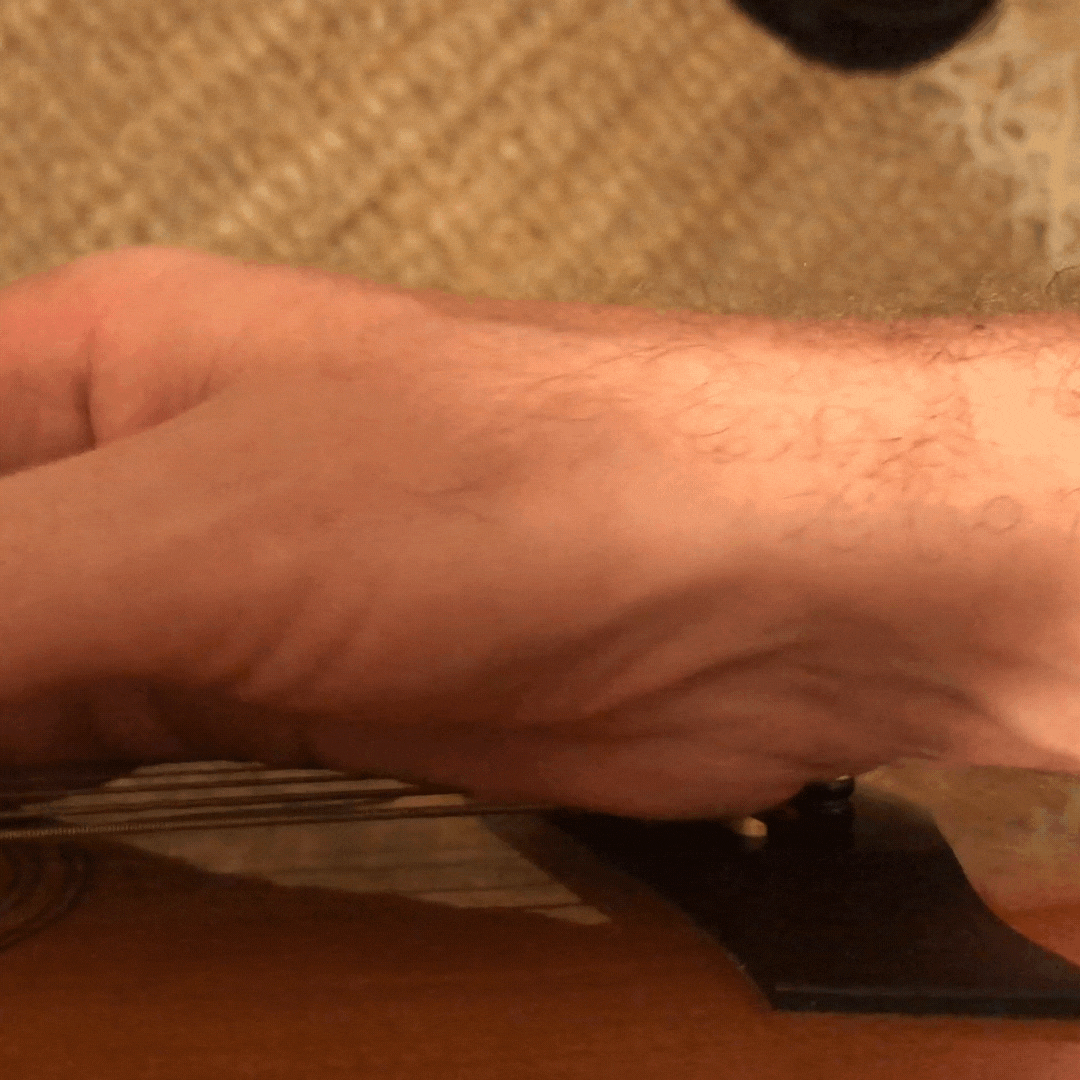
Positioning
Your guitar will sound different depending on where you strum it. For example, if you strum closer to the bridge saddle, you will get a thinner sound.
As you move up towards the guitar neck, you will get a fuller, more bassy sound.
Generally, the default position of strumming is the guitar’s sweet spot. Still, you can get really cool sonic effects by playing other areas of your guitar.
As you become more confident as a guitar player, play around with your strumming positions.
(Audio)
String Sections
You don’t have to strum all the strings. In fact, you can break the six strings of the guitar down into 3 sections.
- Bass (Low E and A)
- Mids (D and G)
- Treble (B and High E)
As you develop more control with your strums, try limiting the strings you hit to one of these three areas.

Strumming on Acoustic Guitar vs. Electric Guitar
There isn’t a correct way to play. However, most people will find it easier to play both electric and acoustic guitar with a pick in the beginning.
However, as you start to get more advanced playing your instrument, you may find it easier to use your fingers on an acoustic.
I generally don’t like playing my favorite acoustic guitars with a pick but like one while playing electric. It’s all up to your own personal style and for you to decide on the kind of guitarist you want to be.
What to do next?
If you study and practice the things in this article, you will become an expert rhythm guitar player in no time.
Remember, like any skill, it takes practice. So don’t be hard on yourself if you’re constantly dropping your pick or cutting your fingers. It happens to the best of us, and you just have to push through.
Eventually, you will gain more control over your wrist and elbow and be able to effortlessly strum to any song.
Once you gain confidence in your playing, it will be time for you to write your own music! So I put together an article that goes through the 5 steps to writing a great song that you should go check out now!
Thanks for reading, and happy playing!

